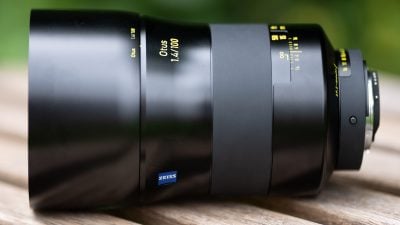Zeiss Otus 100mm f1.4 review
-
-
Written by Thomas
Quality
Testing: Longitudinal Chromatic Aberration and focus shift
Lenses with focal ratios of f2.8 or larger are often prone to longitudinal color aberrations (loCA, a.k.a. “axial color” or “bokeh CA”). These show up as magenta coloration in the foreground and greenish hues in the background and are not easily corrected in post-processing. The new Zeiss Otus is no exception – although dubbed “Apo”chromatic: it shows some loCA at f1.4 and f2.0.
Zeiss 100mm f1.4 Otus Longitudinal Chromatic Aberration (loCA)
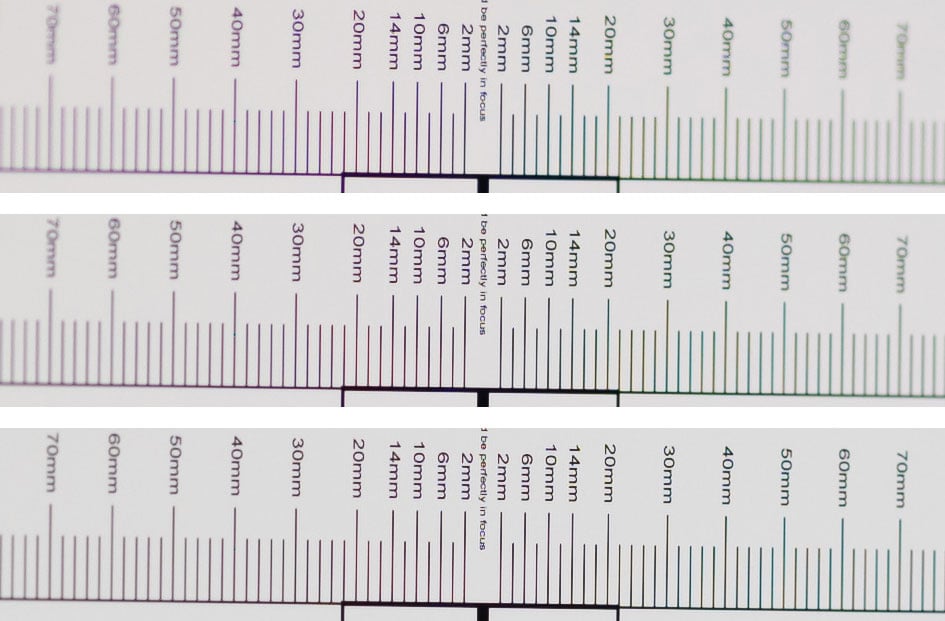
100% crops, from top to bottom: f1.4, f2.0, f2.8; left = foreground, right = background
But in real life shots I found the loCA of the new Otus pretty unobtrusive.
The test also revealed that there is no focus shift to speak of. Following are links to the loCA test result from different large aperture prime lenses (all at f1.4, f2.0, f2.8): Sigma 105mm f1.4 Art, Nikon 105mm f1.4E, Zeiss 85mm f1.4 Otus. The Nikon shows slightly stronger loCA than the new Zeiss 100mm f1.4 Otus, while both the Sigma 105mm f1,4 and the Zeiss 85mm f1.4 Otus produce less loCA.
Sharpness and contrast
Let’s have a look at the theoretical performance of the new Zeiss Otus first and compare it to the performance of some alternatives:
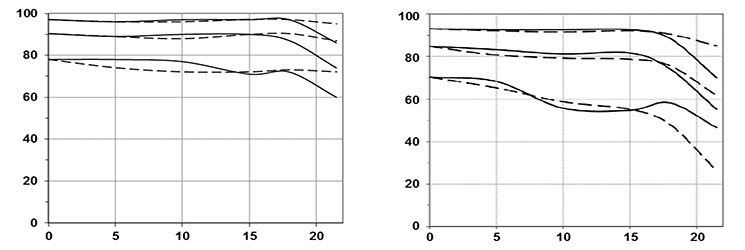
Above: MTF Zeiss 100mm f1.4 Otus at f1.4 (left); Zeiss 85mm f1.4 Otus at f1.4 (right)
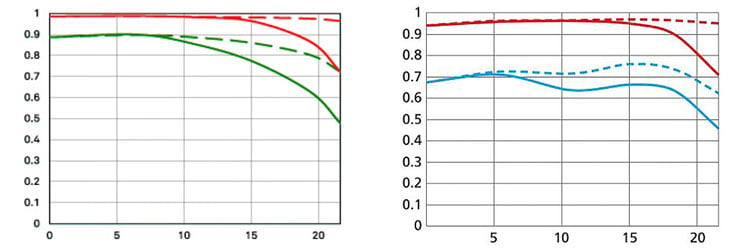
Above: MTF Sigma 105mm f1.4 Art at f1.4 (left); Nikon 105mm f1.4E at f1.4 (right)
The measured MTF charts of the Zeiss lenses show the contrast wide open at 10, 20 and 40 line-pairs per mm including the influence of diffraction. The computed MTF chart of the Sigma and Nikon lenses shows contrast at 10 lp/mm and 30 lp/mm at f1.4 without influence of diffraction – which makes them look slightly better. In these charts higher values are better and the closer the line-pairs are together the less astigmatism (= resolution depends on the orientation of the test-pattern) the lens has. The x-axis displays the distance from the optical axis (= center of the sensor) in mm. I’ll show you the real-life performance at 4 mm (“center”), 13 mm (“APS-C/DX-corner”), and 20 mm (“FF/FX-corner”) on a 46MP Nikon Z7 or D850 body.
From the charts the new Zeiss 100mm f1.4 Otus looks clearly better than the 85mm f1.4 Otus and the Nikon. And even the Sigma Art should be bested in the FF/FX-corner as the new Zeiss Otus shows the hallmark quality of Otus lenses in an exemplary way: very high and very even performance right up into the corners of a full-frame sensor.
Let’s see how this theoretical performance translates into real life results in the sharpness test based on Siemens-stars shot with a 46MP Nikon Z7 or D850 at a distance of around 4.5m. Processing was done in Lightroom 8/CRAW 11 from RAW to Adobe Color profile. Noise-reduction is set to 0, sharpening to 50/0.5/36/10, with no extra tone, color, or saturation adjustment.
White-balance was adjusted to a neutral white and I did some exposure compensation to make the brightness of all crops match. So you will not see light fall-off in the corners. Removal of lateral color aberrations is ON, longitudinal CA are not corrected, no lens profiles were applied.
The following are all 100% crops!
Zeiss 100mm f1.4 Otus; 100% crop from center, APS-C/DX-corner, FF/FX-corner

Above: 100mm, f1.4

Above: 100mm, f2.0

Above: 100mm, f2.8

Above: 100mm, f4.0

Above: 100mm, f5.6

Above: 100mm, f8.0

Above: 100mm, f11
These 100% crops directly from a 46MP Nikon Z7 sensor show very good performance from this lens right from f1.4 with only a touch of softness in the DX-corner. Field curvature at this distance is a non-issue. Stop the lens down to f11 and you can clearly see the effect of diffraction.
The following comparison shows the Zeiss 100mm f1.4 Otus, Sigma 105mm f1.4 Art, Nikon 105mm f1.4E ED, and the Zeiss 85mm f1.4 Otus wide open:
Zeiss 100mm f1.4 Otus; comparison with other lenses at f1.4

Above: Zeiss 100mm f1.4 Otus at f1.4

Above: Sigma 105mm f1.4 Art at f1.4

Above: Nikon 105mm f1.4E ED at f1.4

Above: Zeiss 85mm f1.4Otus at f1.4
Within the APS-C/DX image-circle the Sigma still rules the roost by a slight margin. The new Otus is second followed by the 85mm Otus. The Nikon is clearly the softest of the four lenses. Looking at the FX-corner the new Zeiss 100mm f1.4 Otus takes the lead followed by the Sigma, the 85mm Otus and the Nikon. So the new 100mm Otus clearly shows the most even performance over the full-frame sensor – and that on a very high level.
Performance at long distances
The Siemens-star test-targets are shot at a distance of 45x focal length (i.e. at 4.7 m for 105 mm focal length). But performance of lenses also depends on the shooting distance. Therefore I present another series of test-shots of a city around 1 km away on a 46MP Nikon Z7 or D850. Processing was done in Lightroom 8/CRAW 11 from RAW to Adobe Color profile. Noise-reduction is set to 0, sharpening to 50/0.5/36/10, with no extra tone, color, or saturation adjustment. There’s no tinkering with vignette-control so you see it here as it is produced by the lens. I used manual focus in live view optimized for the center at the largest aperture and did not change focus for other apertures. All shots were made from a heavy tripod at ISO 64 with image stabilization switched off. As usual I have selected the diagonal that provided the better corner results as almost any lens is a bit decentered.
The main image shows the complete scene wide open to give you an impression of the angle of view and to judge vignetting. This is followed by one row of 100% crops from f1.4 to f11 each from the middle, the APS-C/DX-corner and the FF/FX-corner.
You can click on each image to access the large original. Please respect our copyright and only use those images for personal use.
Zeiss 100mm f1.4 Otus
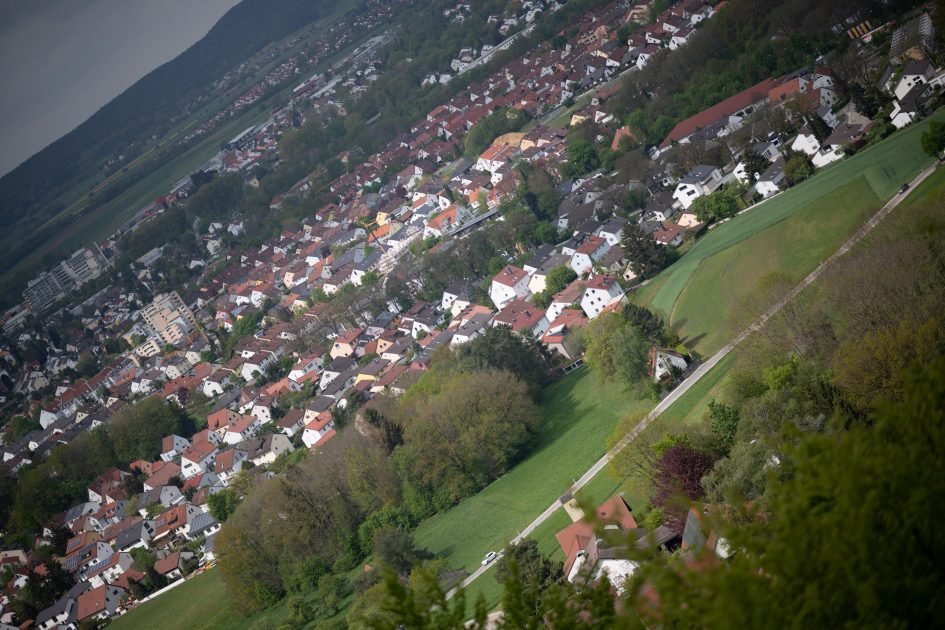
Above: 100mm, f1.4; click image for 4k version, also available as large original at f1.4, f2.0, f2.8, f4.0, f5.6, f8.0, f11

Above: 100mm, f1.4

Above: 100mm, f2.0

Above: 100mm, f2.8

Above: 100mm, f4.0

Above: 100mm, f5.6

Above: 100mm, f8.0

Above: 100mm, f11
In this long distance test the new Zeiss Otus again shows its merit: its performance is very good even wide open across the sensor. The amount of vignetting seems very strong at f1.4. But this impression is exacerbated by the uneven lighting at that time.
I shot the same scene with the Sigma 105mm f1.4 Art, Nikon 105mm f1.4E ED, and Zeiss 85mm f1.4 Otus at another day on the Nikon D850 with more favorable atmospheric conditions. For this comparison I lifted the brightness of the FX-corner for the 100mm Otus a bit to make it easier to compare sharpness:
Zeiss 100mm f1.4 Otus; comparison with other lenses at f1.4

Above: Zeiss 100mm f1.4 Otus at f1.4

Above: Sigma 105mm f1.4 Art at f1.4; 100% crop from center, DX-corner, FX-corner; available as large original at f1.4, f2.0, f2.8, f4.0, f5.6, f8.0, f11

Above: Nikon 105mm f1.4E ED at f1.4; 100% crop from center, DX-corner, FX-corner; available as large original at f1.4, f1.6, f1.8, f2.0, f2.8, f4.0, f5.6, f8.0, f11

Above: Zeiss 85mm f1.4 Otus at f1.4; 100% crop from center, DX-corner, FX-corner; available as large original at f1.4, f1.6, f1.8, f2.0, f2.8, f4.0, f5.6, f8.0, f11
The new Zeiss 100mm f1.4 Otus is clearly up there with the best while the Nikon 105mm f1.4E is (again) the softest in this comparison.
Vignetting
To make it easier to see light fall-off in the corners of a full-frame sensor I’ve arranged a series of shots with the new Zeiss Otus at different apertures. All images were developed to the same brightness in the center. The first row is with no lens profile applied, for the second row I used Adobe’s lens profile for the Zeiss 85mm f1.4 Otus as there is no profile for the newest 100mm Otus yet:
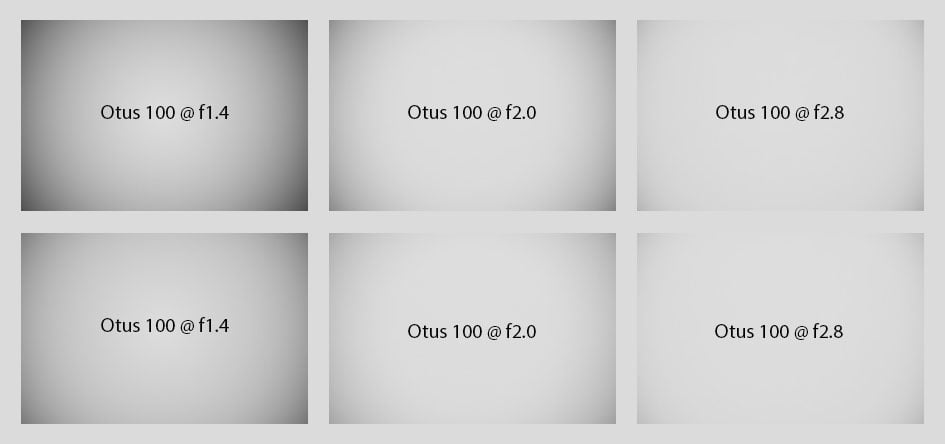
Above: Zeiss 100mm f1.4 Otus, without vignetting correction (1st row) and with lens profile (2nd row)
The sample images above show that the new Otus has very strong vignetting of over 2 stops at f1.4.
Rendering of point-light sources at night-shots
Night-shots pose a different challenge for lenses as the contrast is even higher than under bright sun and point-light sources can reveal some weaknesses such as coma, haloing and colour aberrations that do not show up as prominently in other test-shots. The 100% crops below the main image show the effect of coma in the FX-corner of the new Zeiss Otus and the competition at various apertures:
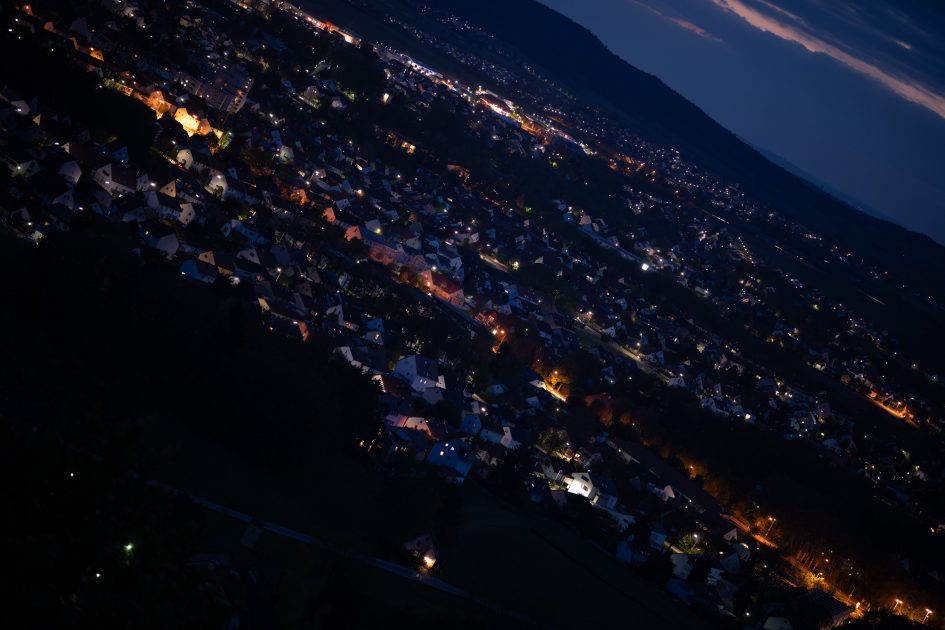
Above: Zeiss 100mm f1.4 Otus at f1.4; click image for 4k version, also available as large original at f1.4, f2.0, f2.8, f4.0, f5.6, f8.0

Above: Zeiss 100mm f1.4 Otus; FF/FX-corner at f1.4 (left), f2.0 (middle), f2.8 (right)

Above: Sigma 105mm f1.4 Art; FF/FX-corner at f1.4 (left), f2.0 (middle), f2.8 (right)

Above: Nikon 105mm f1.4E; FF/FX-corner at f1.4 (left), f2.0 (middle), f2.8 (right)

Above: Zeiss 85mm f1.4 Otus on a D810; FF/FX-corner at f1.4 (left), f2.0 (middle), f2.8 (right)
The new Zeiss Otus has more coma than the excellent Sigma 105mm f1.4 Art but still less than the Nikon 105mm f1.4E and the Zeiss 85mm f1.4 Otus.
Rendering of out-of-focus point-light sources and Bokeh
This test is for the rendering of point-light sources in an out-of-focus background. The circle of confusion that is produced by this test is pretty indicative of Bokeh performance (in the background) and light fall-off. Ideally the out-of-focus image of the point-light is evenly lit and perfectly circular, with no “onion-rings”, and without coloration. Large aperture lenses normally produce an effect known as “cat’s eye” the further away from the optical axis the point-light is projected. This is due to optical vignetting in the lens barrel when light enters the lens from an angle.

Above: Zeiss 100mm f1.4 Otus at f1.4; click image for 4k version, also available as large original at f1.4, f2.0, f2.8, f4.0, f5.6, f8.0

Above: Zeiss 100mm f1.4 Otus at f1.4; 44% crops from center, DX-corner, FX-corner

Above: Sigma 105mm f1.4 Art at f1.4; 44% crops from center, DX-corner, FX-corner; click image for 4k version, also available as large original at f1.4, f2.0, f2.8, f4.0, f5.6

Above: Nikon 105mm f1.4E at f1.4; 44% crops from center, DX-corner, FX-corner; click image for 4k version, also available as large original at f1.4, f1.8, f2.0, f2.8, f4.0, f5.6
The Zeiss 100mm f1.4 Otus produces very big Bokeh balls when used wide open which are just a tiny bit smaller than from the 105mm f1.4 lenses. It exhibits no onion rings which is quite a feat for a lens employing an aspherical lens element. Light-distribution across the circle is very even. and outlining is very low. In both aspects the new 100mm Otus is better than both 105mm alternatives. The Bokeh balls show no green coloration from loCA but there’s a strong cat’s eye effect towards the corners. That there’s no clipping from the mirror-box is simple to explain: The 100mm Otus was shot on the mirrorless Nikon Z7, while the other two were shot on a Nikon D850.
Let’s see how this analysis of out-of-focus point-light sources translates into Bokeh-performance shooting a bookshelf:
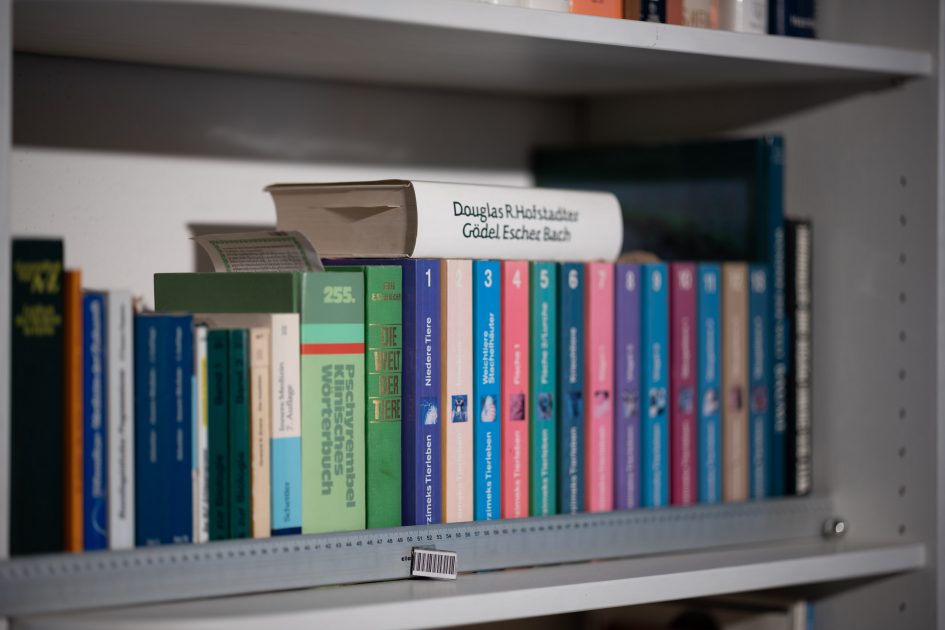
Above: Zeiss 100mm f1.4 Otus at f1.4; click image for 4k version, also available as large original at f1.4, f2.0, f2.8, f4.0, f5.6, f8.0

Above: Zeiss 100mm f1.4 Otus at f1.4; 44% crops from foreground, middle-ground, background

Above: Sigma 105mm f1.4 Art at f1.4; 44% crops from foreground, middle-ground, background; click image for 4k version, also available as large original at f1.4, f2.0, f2.8, f4.0, f5.6

Above: Nikon 105mm f1.4E ED at f1.4 shot on a D810; 50% crops from foreground, middle-ground, background; click image for 4k version, also available as large original at f1.4, f1.8, f2.0, f2.8, f4.0, f5.6, f8.0

Above: Zeiss 85mm f1.4 Otus at f1.4; 44% crops from foreground, middle-ground, background; click image for 4k version, also available as large original at f1.4, f1.8, f2.0, f2.8, f4.0, f5.6, f8.0
Well, the Sigma 105mm f1.4 Art is hard to beat when it comes to Bokeh although the new Zeiss Otus is not bad at all: The transition zone (middle-ground) and the background just show less blur than the Sigma Art.
To see how the Bokeh compares when shooting portraits head over to the Samples section.
Flare/ghosting
A strong light-source shining directly into the lens could produce strange colorful ghosts-images or reduce contrast considerably through flare and glare. The appearance of flare and ghosting depends on factors like the aperture and the angle of the light hitting the lens. So to judge the proclivity of the Zeiss Otus for these artifacts I went through a series of well calculated shots against a strong light source to provoke flare, glare, and ghosting.
The little bright square inset in the upper left of both images below shows the respective area with an exposure compensation of +3 EV to make it easier to see which levels of black the lens renders at that point. It turns out that both the Zeiss Otus and the Sigma Art produce quite some veiling glare at f1.4 but also at f11:
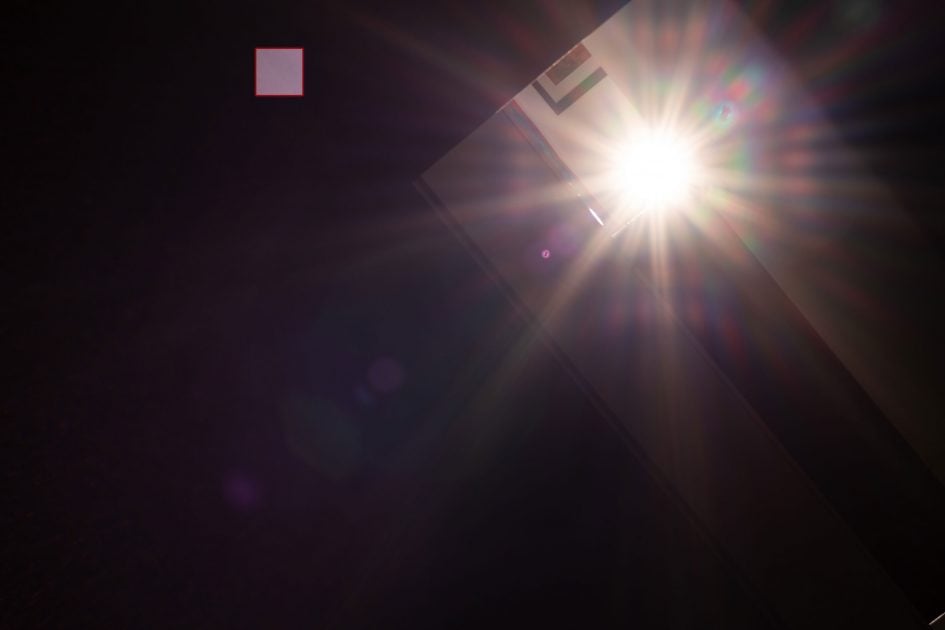
Above: Flare and ghosting. Strong light hitting the Zeiss 100mm f1.4 Otus at f11.0
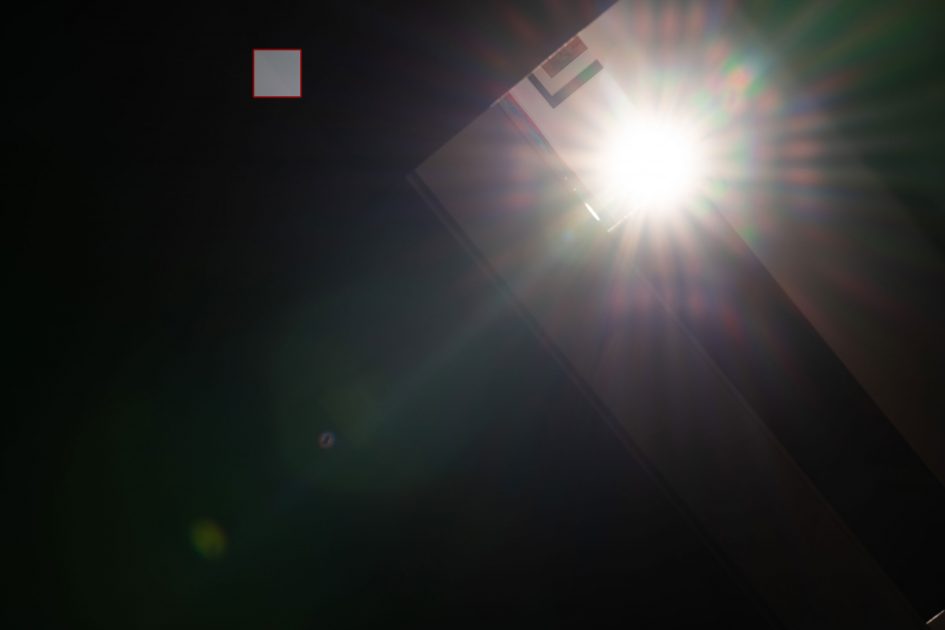
Above: Flare and ghosting. Strong light hitting the Sigma 105mm f1.4 Art at f11.0
When the light was further outside the frame (but still shining into the lens) there was almost no flare or ghosting.
Check prices at Amazon, B&H, Adorama, eBay or Wex. Alternatively get yourself a copy of my In Camera book, an official Cameralabs T-shirt or mug, or treat me to a coffee! Thanks!




